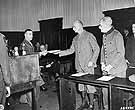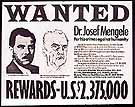
|
|
|

|

|

|

|
|
Click on an image to see a larger, more detailed picture.
|
|
|
|
|
| EPILOGUE: The Aftermath |

|
pg. 668 |

|
|
|
|
| |
 The presumed moral purity of the Wehrmacht was important to postwar Germans. The army's complicity in numerous atrocities became apparent later, and showed that the 1947 trials of General Wilhelm List (above, center) and other military leaders were appropriate.
The presumed moral purity of the Wehrmacht was important to postwar Germans. The army's complicity in numerous atrocities became apparent later, and showed that the 1947 trials of General Wilhelm List (above, center) and other military leaders were appropriate.
Photo: National Archives/United States Holocaust Memorial Museum Photo Archive
|
 Following the war, Dr. Josef Mengele, the sadistic chief physician at Auschwitz, found haven in South America. This wanted poster was released by the Simon Wiesenthal Center in 1985.
Following the war, Dr. Josef Mengele, the sadistic chief physician at Auschwitz, found haven in South America. This wanted poster was released by the Simon Wiesenthal Center in 1985.
Photo: Archive Photos
|
|
News from Germany on May 21, 1999, contained another Holocaust-related story that was noteworthy. It dealt with an ethnic German named Alfons Goeztfried. In 1991 Goetzfried had immigrated to Germany from his native Ukraine as the Soviet Union disintegrated. His move did not succeed, however, in leaving his wartime past behind. The crucial chapter in Goetzfried's story turned out to be that he had been a member of the Gestapo and a participant in the 1943 murder of 17,000 Jews in Poland. Brought to trial in Germany, he was found guilty of war crimes by a state court in Stuttgart. The prosecutor argued for a 13-year prison sentence, which the court denied. Even if the prosecutor's argument had prevailed, it is unclear that Goetzfried's situation would have ended up much differently. After sentencing him to ten years, the court then released Goetzfried on the grounds that he had previously spent 13 postwar years imprisoned in a Soviet labor camp in Siberia. Goetzfried's prosecutors stated that this trial might be the last of Germany's Nazi-era war-crimes trials. For just as Holocaust survivors are aging and dying, the same is true of war-crimes suspects and the witnesses who could testify against them.
|
|
Germany's Struggle with Its Past The murderous legacy of Nazism has cast a long and foreboding shadow over the German nation. Questions of collective guilt and responsibility for the crimes of National Socialism permeate the fabric of German society. Although more than 50 years separate the present day from the end of World War II, Germany still struggles to come to terms with its past. Until the 1960s, discussions of National Socialism were virtually absent from German textbooks. Although questions about culpability for the Holocaust are now cautiously broached in Germany, every effort to memorialize the Holocaust ignites a national debate. On an individual level, German intellectuals have wrestled endlessly about German guilt. Whereas the German philosopher Karl Jaspers rejected the thesis of collective guilt, German theologian Martin Niemöller openly acknowledged it. In his confession "I Am Guilty," Niemöller wrote: "We are most certainly not without guilt; and I ask myself over and over again what would have happened if 14,000 evangelical ministers all over Germany had defended the truth with their very lives in the year 1933 or 1934....I can imagine that we should have saved 30 to 40 million lives."'
|
|

|

|

|

|
 July 23, 1951: Philippe Pétain, head of the collaborationist Vichy government in France, dies in exile on the island of Yeu at age 96.
July 23, 1951: Philippe Pétain, head of the collaborationist Vichy government in France, dies in exile on the island of Yeu at age 96.
|
 September 8, 1951: Jürgen Stroop, former SS-Gruppenführer in charge of the 1943 liquidation of the Warsaw Ghetto, is hanged at Warsaw after being convicted of war crimes.
September 8, 1951: Jürgen Stroop, former SS-Gruppenführer in charge of the 1943 liquidation of the Warsaw Ghetto, is hanged at Warsaw after being convicted of war crimes.
|
 September 27, 1951: West German Chancellor Konrad Adenauer formally apologizes for Nazi persecution of Jews and reiterates his nation's offer of reparations; See January 1951; September 10, 1952.
September 27, 1951: West German Chancellor Konrad Adenauer formally apologizes for Nazi persecution of Jews and reiterates his nation's offer of reparations; See January 1951; September 10, 1952.
|
 1952: The first Criminal Senate of the German Federal Court rules that the official acts of the Nazi regime are invalid because they violate all standards of legality and morality.
1952: The first Criminal Senate of the German Federal Court rules that the official acts of the Nazi regime are invalid because they violate all standards of legality and morality.
|
 February 1952: The Federal Reserve Bank of New York obtains gold plates, buttons, coins, and smoking-pipe ornaments that were apparently stolen from victims of Nazi persecution in Europe. The Federal Reserve later melted down these items and turned them into gold bars, which were turned over to European central banks; See December 1997.
February 1952: The Federal Reserve Bank of New York obtains gold plates, buttons, coins, and smoking-pipe ornaments that were apparently stolen from victims of Nazi persecution in Europe. The Federal Reserve later melted down these items and turned them into gold bars, which were turned over to European central banks; See December 1997.
|
|
|
|
|
| EPILOGUE: The Aftermath |

|
pg. 668 |

|
|
The Holocaust Chronicle
© 2009 Publications International, Ltd.
|
|
